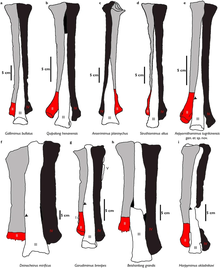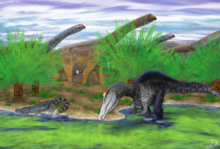User:A Cynical Idealist/sandbox5
| A Cynical Idealist/sandbox5 Temporal range: Early Cretaceous
~125 to 120 Ma - Late | |
|---|---|

| |
| Hypothetical life reconstruction of three Kinnareemimus | |
| Scientific classification | |
| Domain: | Eukaryota |
| Kingdom: | Animalia |
| Phylum: | Chordata |
| Clade: | Dinosauria |
| Clade: | Saurischia |
| Clade: | Theropoda |
| Clade: | Maniraptoriformes |
| Clade: | †Ornithomimosauria |
| Genus: | †Kinnareemimus Buffetaut et al., 2009 |
| Type species | |
| †Kinnareemimus khonkaenensis Buffetaut et al., 2009
| |
| Synonyms | |
| |
Kinnareemimus (/ˌkɪnəriˈmɑːiməs/, meaning "Kinnaree mimic", after a figure from Thai folklore) is an extinct genus of ornithomimosaurian theropod dinosaur that was discovered in the Early Cretaceous Sao Khua Formation in what is now Thailand. The genus contains only the type species, K. khonkaenensis. The specific epithet is after Khon Kaen Province, which is in northeastern Thailand, where the remains of the animal were dicovered.[1]
Discovery and naming[edit]


Ornithomimosaur body fossils and ichnofossils were reported in Thailand's Khorat Plateau as early as 1997 in a publication by Eric Buffetaut and colleagues. At the time, only two dinosaur genera, Siamotyrannus and Phuwiangosaurus had been named from the country. Their report included a drawing of the metatarsals of an ornithomimosaur which had been uncovered at a locality called "Phu Wiang 5". These metatarsals clearly showed the derived arctometatasalian condition, similar to the ornithomimosaurs known from Laramidia. However, this specimen was not identified by any name other than the "Thai ornithomimosaur".[2]
The next mention of the "Thai ornithomimosaur"[3] was in the first edition of the Dinosaur Press magazine, which was published in Japan in 2000.[3] In this publication, the taxon is referred to by the nomen nudum "Ginnareemimus" by Ryuichi Kaneko, who wrote an article in the magazine which contained recent information about paleontology in Thailand.[4][5]
Kinnareemimus received a formal species description in 2009 when Eric Buffetaut, Varavudh Suteethorn, and Haiyan Tong published an anatomical monograph in the bulletin of the Geological Society of London. All the bones referable to ornithomimosaurs found at Phu Wiang 5 were disarticulated, and it is therefore impossible to know exactly how many individual animals were fossilized at the site. For this reason, when Kinnareemimus was described in 2009, only a single partial metatarsal III — designated PW5A-100 — was designated as the holotype. The remaining specimens were each given unique designations (from 101 to 131), and they were each referred to the new genus. Buffetaut and Suteethorn remark in their description that they are confident that all of the material belongs to a single species, but they conservatively did not include the anatomy of these bones in the species diagnosis.[1]
When it was described, the authors named the genus after Kinnaree, a being from the folklore of the Thai people which has the head and torso of a woman and the legs of a bird and lives in the legendary Himmapan Forest. Buffetaut and Suteethorn remark that the choise of Kinnaree was in reference to the birdlike feet of Kinnareemimus.[1]
Description[edit]
Because the holotype of Kinnareemimus is so fragmentary (consisting of only a single metatarsal), estimates of the animal's size have always been highly speculative and uncertain. The authors who described the genus, Eric Buffetaut and colleagues, did not give an estimate of the animal's mass. They remarked that the ratio of the lengths between the tibia and the third metatarsal of Kinnareemimus is most similar to Garudimimus. They interpret this to mean that its body proportions may have been more similar to that genus than to derived genera like Gallimimus or Struthiomimus.[1] It has subsequently been estimated by Molina-Pérez and Larramendi to have been about 1.8 metres (5.9 ft) long and would have possibly weighed around 13 kilograms (29 lb).[6]
Holotype[edit]
Referred specimens[edit]
- Axial skeleton
- Appendicular skeleton
- List of specimens:
| Specimen | Includes |
|---|---|
| PW5A-100 | distal portion of a left metatarsal III |
| PW5A-101 | left metatarsal II |
| PW5A-102 | proximal portion of a left metatarsal IV |
| PW5A-103 | middle portion of a left metatarsal III |
| PW5A-104 | proximal portion of a left metatarsal III |
| PW5A-105 | most of a left metatarsal II |
| PW5A-106 | right metatarsal IV |
| PW5A-107 | distal portion of a right metatarsal III |
| PW5A-108 | proximal portion of metatarsal IV |
| PW5A-109 | proximal portion of metatarsal IV |
| PW5A-110 | right tibia |
| PW5A-111 | left tibia |
| PW5A-112 | proximal portion of a left fibula |
| PW5A-113 | proximal portion of a right pubis |
| PW5A-114 | proximal portion of a left pubis |
| PW5A-115 | pedal phalanx |
| PW5A-116 | pedal phalanx |
| PW5A-117 | pedal phalanx |
| PW5A-118 | pedal phalanx |
| PW5A-119 | pedal phalanx |
| PW5A-120 | pedal phalanx |
| PW5A-121 | pedal phalanx |
| PW5A-122 | partial pedal phalanx with an ungual |
| PW5A-123 | dorsal vertebral centrum |
| PW5A-124 | partial caudal vertebra |
| PW5A-125 | middle caudal vertebral centrum |
| PW5A-126 | distal caudal vertebra |
| PW5A-127 | distal caudal vertebra |
| PW5A-128 | distal caudal vertebra |
| PW5A-129 | distal caudal vertebra |
| PW5A-130 | proximal caudal vertebral centrum |
| PW5A-131 | proximal portion of a right metatarsal III |
Classification[edit]
Evolutionary relationships[edit]
Phylogeny[edit]
Paleobiology[edit]
Paleoecology[edit]
Paleoenvironment[edit]

The Sao Khua Formation has thus far only yielded continental fossils, with no evidence of marine fossils or marine sediments.[9] There have historically been reports of ichthyosaur and plesiosaur teeth from the Sao Khua Formation, but these have now been identified as belonging to crocodyliformes, which are mostly non-marine during the Cretaceous.[10][11] The sediments of the Sao Khua Formation are composed of red clays, mudstones, sandstones, siltstones, and conglomerate rocks, which indicate a fluvial environment which also possessed lakes, floodplains, and braided channels.[9][12]
Contemporary fauna[edit]
Of all the Mesozoic formations in northeastern Thailand, the Sao Khua has the most abundant and diverse vertebrate fossil record.[13] The Phu Wiang 5 locality is specifically known to have included small, possibly juvenile, specimens of the sauropod Phuwiangosaurus. The spinosaurid Siamosaurus is also known from this locality from teeth.[1]
The region was host to numerous other theropods, although it is not known confidently if any of these coexisted with Kinnareemimus specifically. These included the sympatric megaraptorans Phuwiangvenator and Vayuraptor,[1] the large theropod Siamotyrannus, an unnamed spinosaurid (sometimes called "Phu Wiang spinosaurid B"), and an unnamed carcharodontosaurid.[10][14] The area was also home to other small theropods including an unnamed ornithomimosaur, an unnamed compsognathid, and possible ornithurines.[15][16] Sauropod remains are also known from the area that are believed to be distinct from Phuwiangosaurus, but none of them have been formally described or named. However, there have yet to be any ornithischians discovered from the formation.[10]
Freshwater life is abundant in the Sao Khua Formation. These include the neosuchians Siamosuchus, Sunosuchus, and Theriosuchus, numerous species of turtles, amiiform fish, several hybodontiform sharks, and freshwqater bivalves.[12] There is also an indeterminate pterosaur known from the formation.[17]
See also[edit]
- 2009 in archosaur paleontology
- Aptian extinction
- Khorat Group
- List of Asian dinosaurs
- Paleontology in Thailand
- Timeline of ornithomimosaur research
Gallery[edit]
- Paleoenvironment[18]
References[edit]
- ^ a b c d e f Buffetaut, Eric; Suteethorn, Varavudh; Tong, Haiyan (2009). "An early 'ostrich dinosaur' (Theropoda: Ornithomimosauria) from the Early Cretaceous Sao Khua Formation of NE Thailand". In Buffetaut, Eric; Cuny, G.; Le Loeuff, Jean; Suteethorn, Varavudh (eds.). Late Palaeozoic and Mesozoic Ecosystems in SE Asia. Geological Society of London. pp. 229–243. doi:10.1144/SP315.16. ISBN 978-1-86239-275-5. S2CID 128633687. Cite error: The named reference "description" was defined multiple times with different content (see the help page).
- ^ Buffetaut, Eric; Suteethorn, Varavudh; Tong, Haiyan; Chaimanee, Yaowalak; Khansubha, Sasidhorn (1997). "New dinosaur discoveries in the Jurassic and Cretaceous of northeastern Thailand" (PDF). International Conference on Stratigraphy, Tectonic Evolution of Southeast Asia and the South Pacific: 157–161.
- ^ a b Kaneko, Ryuichi (2000). "Following Dinosaur Tracks in Thailand". Dino Press Vol. 1. Japan: Aurora Oval Inc.
- ^ "Dino Press Magazine". Archives of the DINOSAUR Mailing List. 2000.
'Following Dinosaur Tracks in Thailand': article on dinosaur ichnology by Ryuichi Kaneko, with some discussion of Phuwiangosaurus and Siamotyrannus
- ^ "Dinosaur Genera List corrections #150". Archives of the DINOSAUR Mailing List. 2000.
Ryuichi Kaneko's article in the first issue of Dino Press provides the name of an as-yet-undescribed ornithomimid from Thailand, Ginnareemimus (no species name given)
- ^ Molina-Pérez, Rubén; Larramendi, Asier (2019). Dinosaur Facts and Figures: The Theropods and Other Dinosauriformes. Translated by Connolly, David; Ramírez Cruz, Gonzalo Ángel. Illustrated by Andrey Atuchin and Sante Mazzei. Princeton University Press. ISBN 978-0691180311.
- ^ Ikegami, Naoki (2016). "The first record of an ornithomimosaurian dinosaur from the Upper Cretaceous of Japan". Historical Biology. 28 (1–2): 264–269. Bibcode:2016HBio...28..264I. doi:10.1080/08912963.2015.1025389. S2CID 128890475.
- ^ Brusatte, Stephen L.; Lloyd, Graeme T.; Wang, Steve C.; Norell, Mark A. (2014). "Gradual Assembly of Avian Body Plan Culminated in Rapid Rates of Evolution across the Dinosaur-Bird Transition" (PDF). Current Biology. 24 (20): 2386–2392. doi:10.1016/j.cub.2014.08.034. PMID 25264248. S2CID 8879023.
- ^ a b Tucker, Ryan T.; Hyland, Ethan G.; Gates, Terry A.; King, M. Ryan; Roberts, Eric M.; Foley, Elliot K.; Berndt, David; Hanta, Rattanaphorn; Khansubha, Sasa-on; Aswasereelert, Wasinee; Zanno, Lindsay E. (2022). "Age, depositional history, and paleoclimatic setting of Early Cretaceous dinosaur assemblages from the Sao Khua Formation (Khorat Group), Thailand". Palaeogeography, Palaeoclimatology, Palaeoecology. 601: 111107. doi:10.1016/j.palaeo.2022.111107. S2CID 249702713.
- ^ a b c Buffetaut, Eric; Suteethorn, Varavudh (1999). "The dinosaur fauna of the Sao Khua Formation of Thailand and the beginning of the Cretaceous radiation of dinosaurs in Asia". Palaeogeography, Palaeoclimatology, Palaeoecology. 150 (1–2): 13–23. Bibcode:1999PPP...150...13B. doi:10.1016/S0031-0182(99)00004-8. ISSN 0031-0182.
- ^ Buffetaut, Eric; Gilles, Cuny; Le Loeuff, Jean; Suteethorn, Varavudh (2009). Late Palaeozoic and Mesozoic Continental Ecosystems in SE Asia. London: Geological Society of London. pp. 2–3. doi:10.1144/SP315. ISBN 978-1862395633.
- ^ a b Eric, Buffetaut; Varavudh, Suteethorn (1998). Hall, Robert; Holloway, Jeremy D. (eds.). "The biogeographical significance of the Mesozoic vertebrates from Thailand". Biogeography and Geological Evolution of SE Asia. Leiden, The Netherlands: Backhuys Publishers: 83–90.
- ^ Samathi, Adun; Sander, P. Martin; Chanthasit, Phornphen (2021). "A spinosaurid from Thailand (Sao Khua Formation, Early Cretaceous) and a reassessment of Camarillasaurus cirugedae from the Early Cretaceous of Spain". Historical Biology. 33 (12): 3480–3494. doi:10.1080/08912963.2021.1874372. S2CID 233884025.
- ^ Buffetaut, Eric; Suteethorn, Varavudh (January 2012). "A carcharodontosaurid theropod (Dinosauria, Saurischia) in the Sao Khua Formation (Early Cretaceous, Barremian) of Thailand". 2012 EAVP Abstracts: 27–30.
- ^ Buffetaut, Eric; Suteethorn, Varavudh; Le Loeuff, Jean; Khansubha, Sasa-On; Tong, Haiyan; Wongko, K. (January 2005). "The dinosaur fauna from the Khok Kruat Formation (Early Cretaceous) of Thailand". International Conference on Geology, Geotechnology and Mineral Resources of Indochina (GEOINDO 2005): 575–581.
- ^ Buffetaut, Eric; Dyke, Gareth; Suteethorn, Varavudh; Tong, Haiyan (2005-12-01). "First record of a fossil bird from the Early Cretaceous of Thailand". Comptes Rendus Palevol. 4 (8): 681–686. doi:10.1016/j.crpv.2005.06.002. ISSN 1631-0683.
- ^ Cuny, Gilles; Suteethorn, V. (2003-01-01). "A Pterodactyloid tooth from the Sao Khua Formation (Early Cretaceous) of Thailand". Mahasarakham University Journal. 22: 92–98.
- ^ Sales, Marcos A. F.; Lacerda, Marcel B.; Horn, Bruno L. D.; de Oliveira, Isabel A. P.; Schultz, Cesar L. (1 February 2016). "The 'χ' of the Matter: Testing the Relationship between Paleoenvironments and Three Theropod Clades". PLOS ONE. 11 (2): e0147031. Bibcode:2016PLoSO..1147031S. doi:10.1371/journal.pone.0147031. PMC 4734717. PMID 26829315.






